weight Citroen DS4 RHD 2013.5 1.G Owner's Manual
[x] Cancel search | Manufacturer: CITROEN, Model Year: 2013.5, Model line: DS4 RHD, Model: Citroen DS4 RHD 2013.5 1.GPages: 400, PDF Size: 31.86 MB
Page 7 of 400

CHECKS PRACTICAL
INFORMATIONTECHNICAL DATA AUDIO AND
TELEMATICS
235 Bonnet
236 Running out of fuel (Diesel)
237 Petrol engines
238 Diesel engines
239 Checking levels
242 Checks248 Temporary puncture repair
kit
253 Changing a wheel
260 Snow chains
261 Changing a bulb
268 Changing a fuse
274 12 V battery
278 Energy economy mode
279 Changing a wiper blade
279 Very cold climate screen
280 Fitting roof bars
281 Towing the vehicle
283 Towing a trailer
285 Accessories290 Petrol engines
291 Petrol weights
292 Diesel engines
293 Diesel weights
294 Dimensions
295 Identifi cation markings299 Emergency or assistance
301 eMyWay
355 Audio system
012012013013010010011011
Page 58 of 400
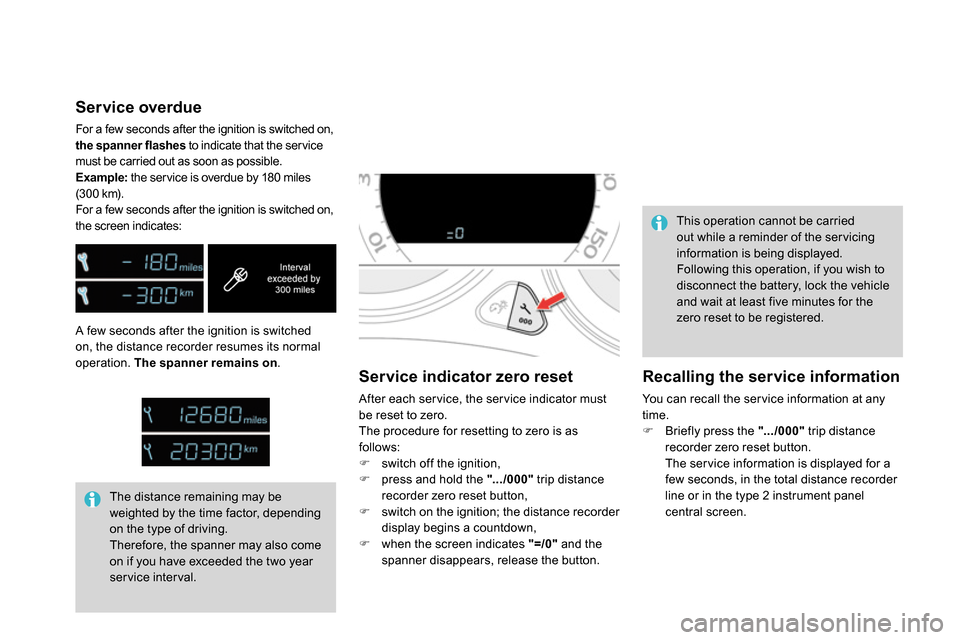
A few seconds after the ignition is switched
on, the distance recorder resumes its normal
operation. The spanner remains on
.
The distance remaining may be
weighted by the time factor, depending
on the type of driving.
Therefore, the spanner may also come
on if you have exceeded the two year
service interval.
Service indicator zero reset
After each ser vice, the ser vice indicator must
be reset to zero.
The procedure for resetting to zero is as
follows:
switch off the ignition,
press and hold the ".../000"
trip distance
recorder zero reset button,
switch on the ignition; the distance recorder
display begins a countdown,
when the screen indicates "=/0"
and the
spanner disappears, release the button. This operation cannot be carried
out while a reminder of the ser vicing
information is being displayed.
Following this operation, if you wish to
disconnect the battery, lock the vehicle
and wait at least five minutes for the
zero reset to be registered.
Recalling the service information
You can recall the ser vice information at any
time.
Briefly press the ".../000"
trip distance
recorder zero reset button.
The ser vice information is displayed for a
few seconds, in the total distance recorder
line or in the type 2 instrument panel
central screen.
Service overdue
For a few seconds after the ignition is switched on,
the spanner flashes
to indicate that the ser vice
must be carried out as soon as possible.
Example:
the ser vice is overdue by 180 miles
(300 km).
For a few seconds after the ignition is switched on,
the screen indicates:
Page 162 of 400
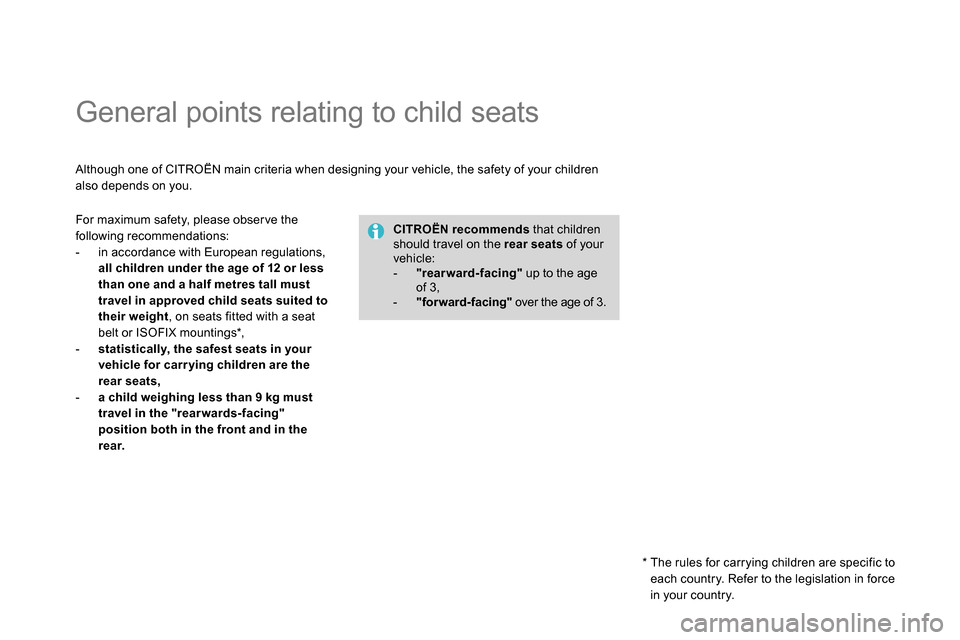
General points relating to child seats
Although one of CITROËN main criteria when designing your vehicle, the safety of your children
also depends on you.
CITROËN recommends
that children
should travel on the rear seats
of your
vehicle:
- "rearward-facing"
up to the age
of 3,
- "forward-facing"
over the age of 3.
For maximum safety, please obser ve the
following recommendations:
- in accordance with European regulations,
all children under the age of 12 or less
than one and a half metres tall must
travel in approved child seats suited to
their weight
, on seats fitted with a seat
belt or ISOFIX mountings * ,
- statistically, the safest seats in your
vehicle for carr ying children are the
rear seats,
- a child weighing less than 9 kg must
travel in the "rear wards-facing"
position both in the front and in the
rear.
*
The rules for carrying children are specific to
each country. Refer to the legislation in force
in your country.
Page 169 of 400
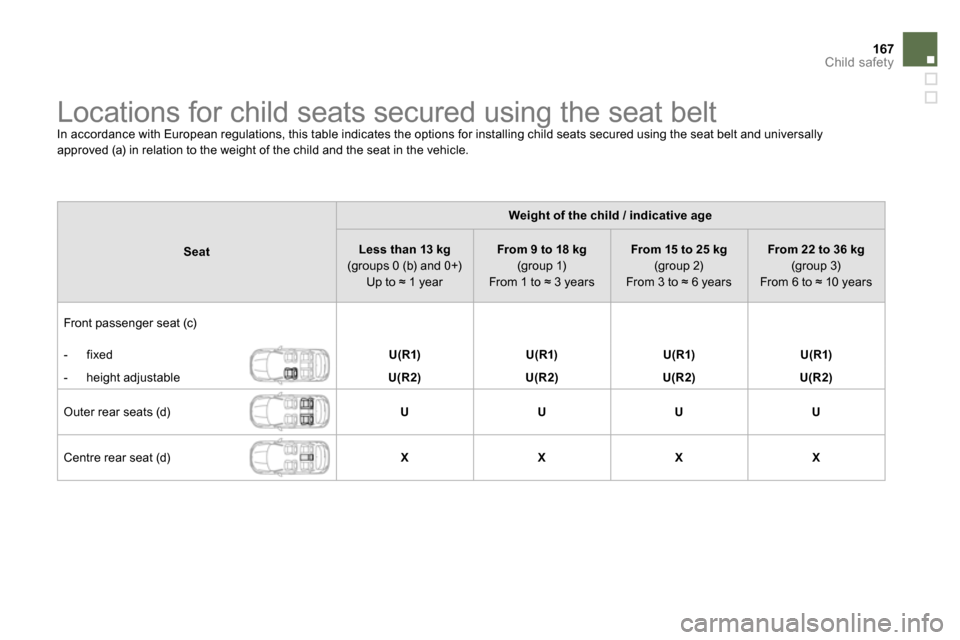
167Child safety
Locations for child seats secured using the seat belt
In accordance with European regulations, this table indicates the options for installing child seats secured using the seat belt and universally
approved (a) in relation to the weight of the child and the seat in the vehicle.
Seat
Weight of the child / indicative age
Less than 13 kg
(groups 0 (b) and 0+)
Up to ≈ 1 year
From 9 to 18 kg
(group 1)
From 1 to ≈ 3 years
From 15 to 25 kg
(group 2)
From 3 to ≈ 6 years
From 22 to 36 kg
(group 3)
From 6 to ≈ 10 years
Front passenger seat (c)
- fixed
U(R1)
U(R1)
U(R1)
U(R1)
- height adjustable
U(R2)
U(R2)
U(R2)
U(R2)
Outer rear seats (d)
U
U
U
U
Centre rear seat (d)
X
X
X
X
Page 170 of 400

(a) Universal child seat: child seat which can be
installed in all vehicles using the seat belt.
(b) Group 0: from birth to 10 kg. Infant car seats
and "car cots" cannot be installed on the
front passenger seat.
(c) Consult the legislation in force in your
country before installing your child on this
seat.
(d) To install a child seat at the rear, backward
or for ward facing, move the front seat
for ward, then straighten the backrest to
allow enough room for the child seat and the
child's legs.
Remove and stow the head restraint
before installing a child seat with
backrest on a passenger seat. Refit the
head restraint once the child seat has
been removed.
U
: seating position suitable for the installation
of a child seat secured using the seat belt
and universally approved "rear ward facing"
and/or "forward facing".
U(R1)
: identical to U
, with the vehicle's seat
backrest inclined fully for wards.
U(R2)
: identical to U
, with the vehicle's seat
adjusted to the highest position.
X
: seating position not suitable for installing a
child seat for the weight group indicated.
Page 173 of 400
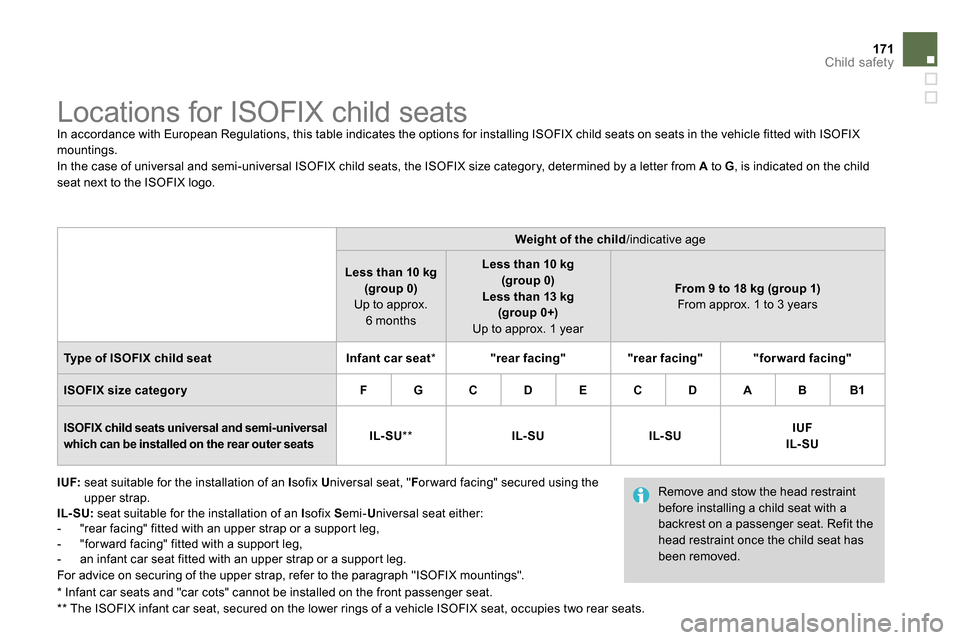
171Child safety
Locations for ISOFIX child seats
In accordance with European Regulations, this table indicates the options for installing ISOFIX child seats on seats in the vehicle fitted with ISOFIX
mountings.
In the case of universal and semi-universal ISOFIX child seats, the ISOFIX size category, determined by a letter from A
to G
, is indicated on the child
seat next to the ISOFIX logo.
IUF:
seat suitable for the installation of an I
sofix U
niversal seat, " F
or ward facing" secured using the
upper strap.
IL-SU:
seat suitable for the installation of an I
sofix S
emi- U
niversal seat either:
- "rear facing" fitted with an upper strap or a support leg,
- "for ward facing" fitted with a support leg,
- an infant car seat fitted with an upper strap or a support leg.
For advice on securing of the upper strap, refer to the paragraph "ISOFIX mountings".
* Infant car seats and "car cots" cannot be installed on the front passenger seat.
** The ISOFIX infant car seat, secured on the lower rings of a vehicle ISOFIX seat, occupies two rear seats.
Weight of the child
/indicative age
Less than 10 kg
(group 0)
Up to approx.
6 months
Less than 10 kg
(group 0)
Less than 13 kg
(group 0+)
Up to approx. 1 year
From 9 to 18 kg (group 1)
From approx. 1 to 3 years
Type of ISOFIX child seat
Infant car seat
*
"rear facing"
"rear facing"
"forward facing"
ISOFIX size category
F
G
C
D
E
C
D
A
B
B1
ISOFIX child seats universal and semi-universal
which can be installed on the rear outer seats
IL-SU
**
IL-SU
IL-SU
IUF
IL-SU
Remove and stow the head restraint
before installing a child seat with a
backrest on a passenger seat. Refit the
head restraint once the child seat has
been removed.
Page 282 of 400

Fitting roof bars
For safety reasons and to avoid damaging the
roof, it is essential to use the transverse bars
approved for your vehicle.
When fitting roof bars, use only the four fixing
points located in the roof frame. The points are
masked by the vehicle doors when closed.
Remove the protective covers, levering them
off with a screwdriver. Take care not to scratch
the paint.
The roof bar fixings include a stud to be fitted to
the hole at each fixing point.
Obser ve the fitting instructions and the
conditions of use in the guide supplied with
the bars.
Keep the protective covers safe so that they
can be refitted after removing the roof bars.
Maximum authorised weight on the roof
rack, for a loading height not exceeding
40 cm (with the exception of bicycle
carriers): 80
kg
.
As this value is subject to change,
check the maximum load figure given in
the guide provide d with the roof bars.
If the height exceeds 40 cm, adapt the
speed of the vehicle to the profile of the
road to avoid damaging the roof bars
and the fixings on the vehicle.
Be sure to refer to national legislation in
order to comply with the regulations for
transporting objects which are longer
than the vehicle.
Page 283 of 400
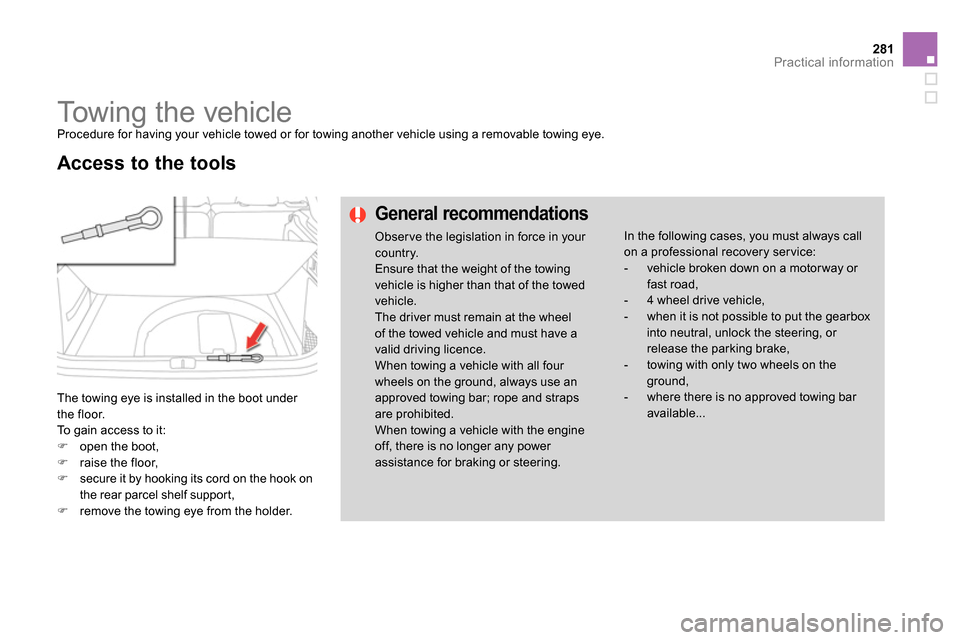
281Practical information
Towing the vehicle
Procedure for having your vehicle towed or for towing another vehicle using a removable towing eye.
The towing eye is installed in the boot under
the floor.
To gain access to it:
open the boot,
raise the floor,
secure it by hooking its cord on the hook on
the rear parcel shelf support,
remove the towing eye from the holder.
Access to the tools
General recommendations
Observe the legislation in force in your
country.
Ensure that the weight of the towing
vehicle is higher than that of the towed
vehicle.
The driver must remain at the wheel
of the towed vehicle and must have a
valid driving licence.
When towing a vehicle with all four
wheels on the ground, always use an
approved towing bar; rope and straps
are prohibited.
When towing a vehicle with the engine
off, there is no longer any power
assistance for braking or steering. In the following cases, you must always call
on a professional recovery ser vice:
- vehicle broken down on a motor way or
fast road,
- 4 wheel drive vehicle,
- when it is not possible to put the gearbox
into neutral, unlock the steering, or
release the parking brake,
- towing with only two wheels on the
ground,
- where there is no approved towing bar
available...
Page 286 of 400
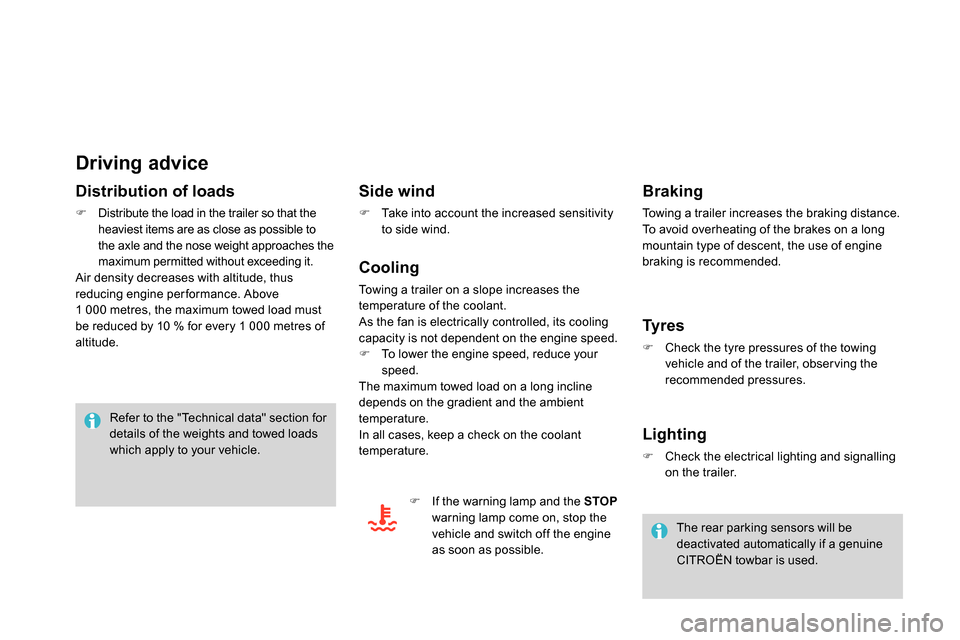
Driving advice
Distribution of loads
Distribute the load in the trailer so that the
heaviest items are as close as possible to
the axle and the nose weight approaches the
maximum permitted without exceeding it.
Air density decreases with altitude, thus
reducing engine per formance. Above
1 000 metres, the maximum towed load must
be reduced by 10 % for every 1 000 metres of
altitude.
Side wind
Take into account the increased sensitivity
to side wind.
Cooling
Towing a trailer on a slope increases the
temperature of the coolant.
As the fan is electrically controlled, its cooling
capacity is not dependent on the engine speed.
To lower the engine speed, reduce your
speed.
The maximum towed load on a long incline
depends on the gradient and the ambient
temperature.
In all cases, keep a check on the coolant
temperature.
If the warning lamp and the STOP
warning lamp come on, stop the
vehicle and switch off the engine
as soon as possible.
The rear parking sensors will be
deactivated automatically if a genuine
CITROËN towbar is used.
Braking
Towing a trailer increases the braking distance.
To avoid overheating of the brakes on a long
mountain type of descent, the use of engine
braking is recommended.
Ty r e s
Check the tyre pressures of the towing
vehicle and of the trailer, obser ving the
recommended pressures.
Lighting
Check the electrical lighting and signalling
on the trailer.
Refer to the "Technical data" section for
details of the weights and towed loads
which apply to your vehicle.
Page 293 of 400
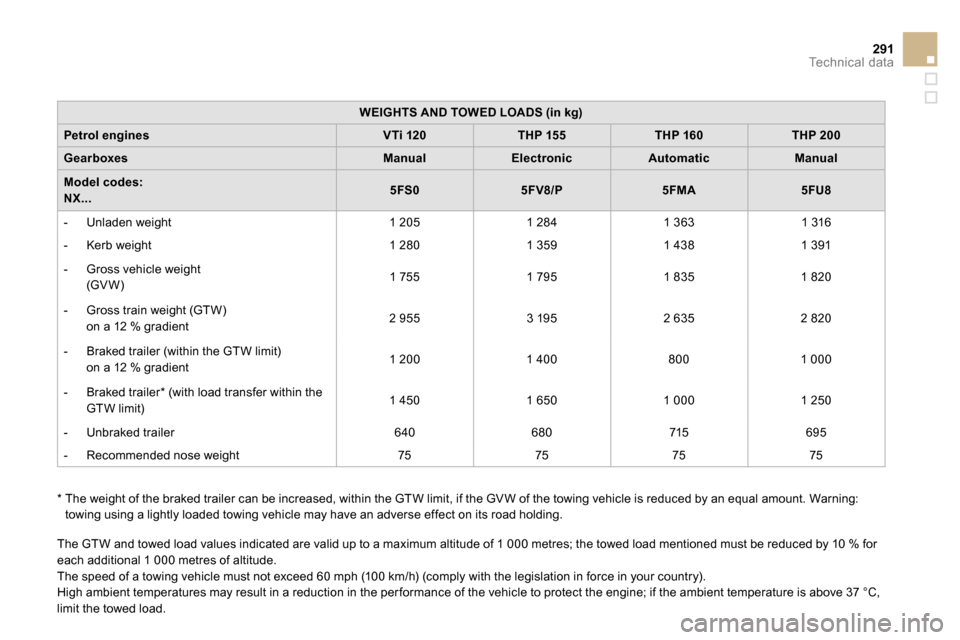
291Te c h n i c a l d a t a
WEIGHTS AND TOWED LOADS (in kg)
Petrol engines
VTi 120
THP 155
THP 160
THP 200
Gearboxes
Manual
Electronic
Automatic
Manual
Model codes:
NX...
5FS0
5FV8/P
5FMA
5FU8
- Unladen weight
1 205
1 284
1 363
1 316
- Kerb weight
1 280
1 359
1 438
1 391
- Gross vehicle weight
(GV W)
1 755
1 795
1 835
1 820
- Gross train weight (GTW)
on a 12 % gradient
2 955
3 195
2 635
2 820
- Braked trailer (within the GTW limit)
on a 12 % gradient
1 200
1 400
800
1 000
- Braked trailer * (with load transfer within the
GTW limit)
1 450
1 650
1 000
1 250
- Unbraked trailer
640
680
715
695
- Recommended nose weight
75
75
75
75
The GTW and towed load values indicated are valid up to a maximum altitude of 1 000 metres; the towed load mentioned must be reduced by 10 % for
each additional 1 000 metres of altitude.
The speed of a towing vehicle must not exceed 60 mph (100 km/h) (comply with the legislation in force in your country).
High ambient temperatures may result in a reduction in the per formance of the vehicle to protect the engine; if the ambient temperature is above 37 °C,
limit the towed load.
*
The weight of the braked trailer can be increased, within the GTW limit, if the GV W of the towing vehicle is reduced by an equal amount. Warning:
towing using a lightly loaded towing vehicle may have an adverse effect on its road holding.